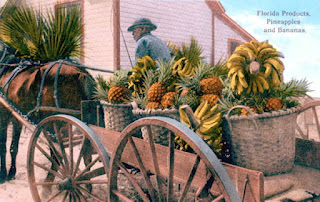 |
| Florida products: pineapples and bananas 1906 State of Florida Archives, postcard collection |
By Jane Feehan
Most associate Florida with citrus but the state had a brief affair with pineapples.
A smattering of towns along its east coast remind us about its pineapple past with mention of today's Pineapple Grove in Delray Beach, the Jensen Beach Pineapple festival and other such references by Stuart and towns as far south as Key West.
Pineapples were first grown in the state in Key West, on Plantation Key and at Merritt Island during the 1860s. The expansion of the Florida East Coast Railway during the 1890s contributed to the growth of the pineapple industry northward to St. Lucie County and beyond.
The Miami Metropolis claimed (Sept. 29,
1916) that “60 percent of all pineapples grown in the U.S. were raised here
[Florida].” Before 1915, “more pineapples were grown around Fort Pierce than
citrus.” (Miami Herald, Oct. 20, 1957)
By 1916, however, pineapple growing had been on the wane; it was nearly over. In 1908-1909, the Florida industry faced stiff competition from Cuba. There was no tariff protection nor significant organizing of pineapple growers’ associations to fight for protection and to lower shipping costs that favored Cuba’s pineapple growers.
In 1909-1910 Florida growers also dealt with “red wilt,” a disease that rotted plant roots. The final blow came with World War I, an event that diminished the availability of appropriate pineapple fertilizers. Some tried to revive the Florida pineapple industry during the 1930s, but failed. By that time, Hawaii claimed predominance in pineapple crops.
It’s interesting to note (or remember for cocktail conversation trivia) that Florida grew pineapples commercially before Hawaii was designated a U.S. Territory in 1898.
Discussion of commercial pineapple possibilities in Hawaii appeared in newspapers before that year. The Hawaiian Gazette (May 26, 1880) suggested pineapples would be a good crop for the hillside land near Hilo on the Island of Hawai’i (“Big Island”). “They could be grown as easily as potatoes,” reported the Pacific Commercial Advertiser (June 27, 1874).
According to the Hawaii Ocean Project, pineapples were not grown commercially until James D. Dole arrived in 1899. By the 1930s, the island became the “top pineapple producer in the world.” (Is their volcanic soil better?).
Before Florida closed this
chapter in its agriculture history, local newspapers were peppered with
pineapple recipes and ideas for: pineapple syrup, pie, preserves, marmalade,
jelly and cheese. Today, the list grows. Pina Colada or pineapple pizza
anyone?
Copyright © 2023. All rights reserved. Jane Feehan
Sources:
Pacific Commercial Advertiser, June 27, 1874
The Hawaiian Gazette, May 26, 1880
Evening Bulletin (Honolulu), Nov. 17, 1892
Miami Metropolis, May 27, 1909
Miami News, June 4, 1909
Miami Metropolis, Sept. 29, 1916
Miami Herald, Oct. 20, 1957
Florida Memory. "A
Prickly Tale: The History of Pineapples in Florida." Floridiana, 2014. https://www.floridamemory.com/items/show/295199.
https://hawaiioceanproject.com/a-brief-history-of-pineapple-in-hawaii/
Tags: Florida pineapples, Florida crops, South Florida agriculture, pineapples, St. Lucie County, Jensen Beach, Stuart, Jane Feehan


